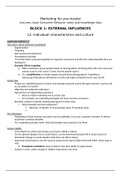Marketing for pre-master
Lectures, book Consumer Behavior notes and knowledge clips
BLOCK 1: EXTERNAL INFLUENCES
L2: Individual characteristics and culture
Lecture notes L2
How does culture influence marketing?
- Segmentation
- Targeting
- New product development
- Promotional activities
Careful when using demographics to segment consumers and infer the values/benefits they are
looking for.
- Example: Ethnic targeting
o Often marketeers group people based on demographics, throwing them all in the same pot:
women want X, men want Y, lower income people want Z.
o It’s a simplification to cluster people around those demographics! Targeting to
sub-groups/subcultures/ethnicities is costly and might sometimes harm your brand.
Social class
- People are classified based on esteem and prestige acquired mainly through economic success and
accumulation of wealth.
- Objective and subjective indicators.
- Natural form of segmenting customers
o Need to match marketing mix to social class
o For example: use marketing strategies for lower income consumers
- Example: Unilever in Brazil; washing detergent for lower class.
o Which benefits are they looking for?
Attribute benefit instrumental value terminal value
Key takeaways
- Marketing to lower income consumers can be profitable, if you are customer-oriented deliver
important customer benefits
- The marketing principle works, find what people want and give it to them.
Social mobility
- Is the degree to which social status can chance within a culture.
- Can be upward (people rise in social status), can be downward (people fall in social status) of
horizontal (change in social situation that does not affect status)
- Expressed social status is not the same as actual social status (high-end brand which shows logo or
not)
o Fraudulent symbolism: when products lose their ability to signal status
- Culture is cyclic: values change in relative importance over time
,Book notes L2
Chapter 12: Consumer diversity
How age affects consumer behavior
- Marketeers often segment by age, making groups of people in similar life stages
1. Teens and millennials (generation Y) easily influenced by others
2. Generation X (1965-1979) react to nostalgia
3. Baby boomers (1946-1964) lot of buying power, but they save for their retirement
4. Seniors (65 plus) they get help making decisions
- Millennials are ‘idealistic’ seek 4 benefits from tech devices:
1. Immediacy
2. Social interaction
3. Entertainment
4. Self-expression
- Distinguish age groups from birth cohorts (same groups but in different eras)
- Brand loyalty starts at teenager and stays.
- Boomers sandwich generation: caring for parents and baby
How gender and sexual orientation affect consumer behavior
- Males have argentic goals: they stress mastery, self-assertiveness, self-efficacy, strength and no
emotion
- Women have communal goals: they stress affiliation, relationships with others, submissiveness,
emotionality and home orientation
but traditional roles are shifting
- Sexual orientation is the preference towards a certain behavior: masculine or feminine.
o Presence of more and more same sex households
,Chapter 13: household and social class influences
How the household influences consumer behavior
- Family can be:
o Nuclear family (gezin)
o Extended family (familie)
o Household (1 person or multiple people that are not a family)
- Family life cycle= different stages at family life, depending on the age of parents and how many
children are living at home
- 5 main influences on households:
1. Delayed marriage and cohabitation career goes first
2. Dual-career families higher spending, want to save time
3. Divorce new consumption/ identity
4. Smaller families more consumption, more spent at 1 child
5. Same sex/ transgender households special products needed
Roles that household members play
- Tasks: gatekeeper (info), influencer (opinion), decider, buyer user
o Instrumental roles relate to tasks affecting the buying decision
o Expressive roles relate to family norms (color/style)
- 4 mayor decision categories for husband and wife
1. Husband-dominant decision
2. Wife-dominant decision
3. Autonomic decision (husband/wife are both likely to)
4. Syncretic decision (together)
- Children can use their influence, they might nag
Social class
- Social class hierarchy
o High (think most alike)
o Middle
o Lower (think mostly different)
- Social classes influence each other (mostly from within)
o Trickle-down theory: trends start in upper classes and move to lower classes
o Status float theory: trends start in lower class and move up to upper classes
- Social class is determined by:
o Income (partly true: blue collar > white collar, but are in same social class)
Social class can often explain how income is used
o Occupation and education
Same occupation same income, lifestyle, knowledge
Education occupation social class
o Other indicators
Neighborhood, possessions, family background etc.
Inherited or earned status
, - How social class changes over time
o Upward mobility raising one’s status level
By education/ occupation, depends on the opportunities
o Downward mobility losing one’s social standing
Increasing trend, as jobs are sent overseas, and technology is rising
o Social class fragmentation disappearance of class distinctions
Upward/ downward mobility
Adopting other behavior through mass media
Interaction between classes by communication technology
Figure 1. Bron: Hoyer, W. D., MacInnis, D. J., Pieters, R., Chan, E., & Northey, G. (2020). Consumer behaviour.
Cengage AU.
How does social class affect consumption?
- Conspicuous consumption (opposite to voluntary simplicity): is the acquisition of goods for social
status.
- Status symbols: judging others on what they own
o Parody display: status symbols that start in lower class and move upward, upper class
people seek status by mocking it
o Fraudulent symbols: symbol that becomes so widely adopted that it loses its status.
- Compensatory consumption: to offset frustrations or difficulties.
- Meaning of money
The consumption patterns of specific social classes
- Upper class: common values and consumption, self-expression via consumption.
- Middle class: varying consumption patterns, look up to upper class.
- Working class: depend on family members, local orientation.
- Homeless: struggle for survival, scavenging!






